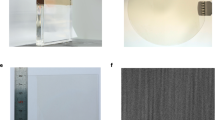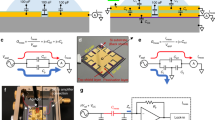Abstract
To communicate, spacecraft and satellites rely on microwave devices, which at present are based on relatively inefficient thermionic electron sources that require heating and cannot be switched on instantaneously. Here we describe a microwave diode that uses a cold-cathode electron source consisting of carbon nanotubes1 and that operates at high frequency and at high current densities. Because it weighs little, responds instantaneously and has no need of heating, this miniaturized electron source should prove valuable for microwave devices used in telecommunications.
Similar content being viewed by others
Main
We constructed a microwave diode in which the carbon-nanotube field-emission source was directly driven at gigahertz (GHz) frequencies. Arrays of vertically aligned carbon nanotubes were integrated on a coaxial post in a resonant cavity. In the device simulation shown in Fig. 1a, radiofrequency electromagnetic radiation at the input induces a high, oscillating electric field at the end of the coaxial post; this electric field is further amplified by the carbon-nanotube array (for details, see supplementary information).
a, Simulation of the coaxial resonant cavity (a cross-section is shown) that was used to generate a high electric field (red) at the carbon-nanotube-array cathode from the radiofrequency input; colour scale shows the applied macroscopic electric field in volts (×105) per metre. White arrow, coaxial radiofrequency input; black arrow, emitted electron beam, collected by an antenna; scale bar 10 mm. b, Electron micrograph of the carbon-nanotube-array cold cathode at a tilt of 45°. The carbon nanotubes have an average diameter of 49 nm, height of 5.5 µm and a spacing of 10 µm; scale bar, 15 µm. Inset, photograph of 16 cathodes. c, Representation of the equivalent electrical circuit, where E is the applied electric field and I is the emitted current; CN, carbon nanotube array. d, Measured average current density plotted against applied radiofrequency electric field using 1.5-GHz sinusoidal input. The circled point corresponds to I=3.2 mA. The cavity-quality factor was 3,160 (see supplementary information).
The carbon-nanotube array (Fig. 1b) consists of uniform individual carbon nanotubes2 spaced at a distance corresponding to roughly twice their height in order to minimize electrostatic-field shielding from adjacent emitters3. Each cathode has an active area of 0.5×0.5 mm2 (or 2,500 carbon nanotubes) and 16 cathodes can be created simultaneously (Fig. 1b, inset).
The device was operated at 1.5 GHz using various radiofrequency-input powers to generate different macroscopic electric fields at the array of carbon-nanotube emitters. As the cavity walls and emitters are grounded, the radiofrequency electric field exists only inside the cavity, as shown in the equivalent electrical circuit in Fig. 1c. A spectrum analyser connected to the output antenna confirmed the presence of the fundamental 1.5-GHz peak in the cavity. In this study, cathodes were operated at 1 mA and 1.5 GHz for 40 h without degradation or a decrease in current output (within the measurement error of 5%). With an applied radiofrequency electric field of 29 megavolts per metre, the output at the anode reaches 3.2 mA, with an average current density of 1.3 A cm−2 (Fig. 1d). This corresponds to a peak current of 30 mA and a current density of 12 A cm−2 in the output waveform (see supplementary information).
The ability directly to generate or modulate an electron beam at high current density and gigahertz frequencies from carbon nanotubes is an important technological advance. Thermionic sources used in today's microwave devices are operated by direct current or at low frequency; their electron beam is usually modulated downstream in an extended interaction line, leading to physically long devices. In contrast, carbon-nanotube cold cathodes that have a vacuum gap to a stand-off grid or anode of a few hundred micrometres or less, as we describe here, have low capacitances and can be operated at very high frequencies (for example, 32-GHz modulation of carbon-nanotube emitters has been achieved from a microwave diode and triode; L.H. et al., manuscript in preparation). They can therefore be used directly as the input stage of a microwave amplifier.
Carbon-nanotube emitters are robust and do not suffer from electromigration because of their strong C–C covalent bonding. Metal emitters, on the other hand, often fail owing to field-induced sharpening, which leads to thermal runaway of the emitters.
Our carbon-nanotube cathode already delivers average- and peak-current densities that are similar to those used in present-day microwave transmission devices. Because of their small size, and ability to generate and modulate the beam directly and on demand without the need for high temperatures, carbon-nanotube cathodes hold promise for a new generation of lightweight, efficient and compact microwave devices for telecommunications in satellites or spacecraft.
References
de Jonge, N. & Bonard, J. M. Phil. Trans. R. Soc. Lond. A 362, 2239–2266 (2004).
Teo, K. B. K. et al. Nanotechnology 14, 204–211 (2003).
Nilsson, L. et al. Appl. Phys. Lett. 76, 2071–2073 (2000).
Author information
Authors and Affiliations
Corresponding author
Ethics declarations
Competing interests
The authors declare no competing financial interests.
Supplementary information
Rights and permissions
About this article
Cite this article
Teo, K., Minoux, E., Hudanski, L. et al. Carbon nanotubes as cold cathodes. Nature 437, 968 (2005). https://doi.org/10.1038/437968a
Published:
Issue Date:
DOI: https://doi.org/10.1038/437968a
This article is cited by
-
Carbon Nanotube-Based 2-Dimensional and 3-Dimensional Field Emitter Structures
Journal of Electronic Materials (2021)
-
A HfC nanowire point electron source with oxycarbide surface of lower work function for high-brightness and stable field-emission
Nano Research (2020)
-
Carbon nanotubes: synthesis, properties and engineering applications
Carbon Letters (2019)
-
Generation of microwave and terahertz radiation in a medium of nanoparticles
Optical and Quantum Electronics (2019)
-
Improved field emission properties of ZnO NRs using Al-doped and post oxygen annealing
Microsystem Technologies (2018)
Comments
By submitting a comment you agree to abide by our Terms and Community Guidelines. If you find something abusive or that does not comply with our terms or guidelines please flag it as inappropriate.




